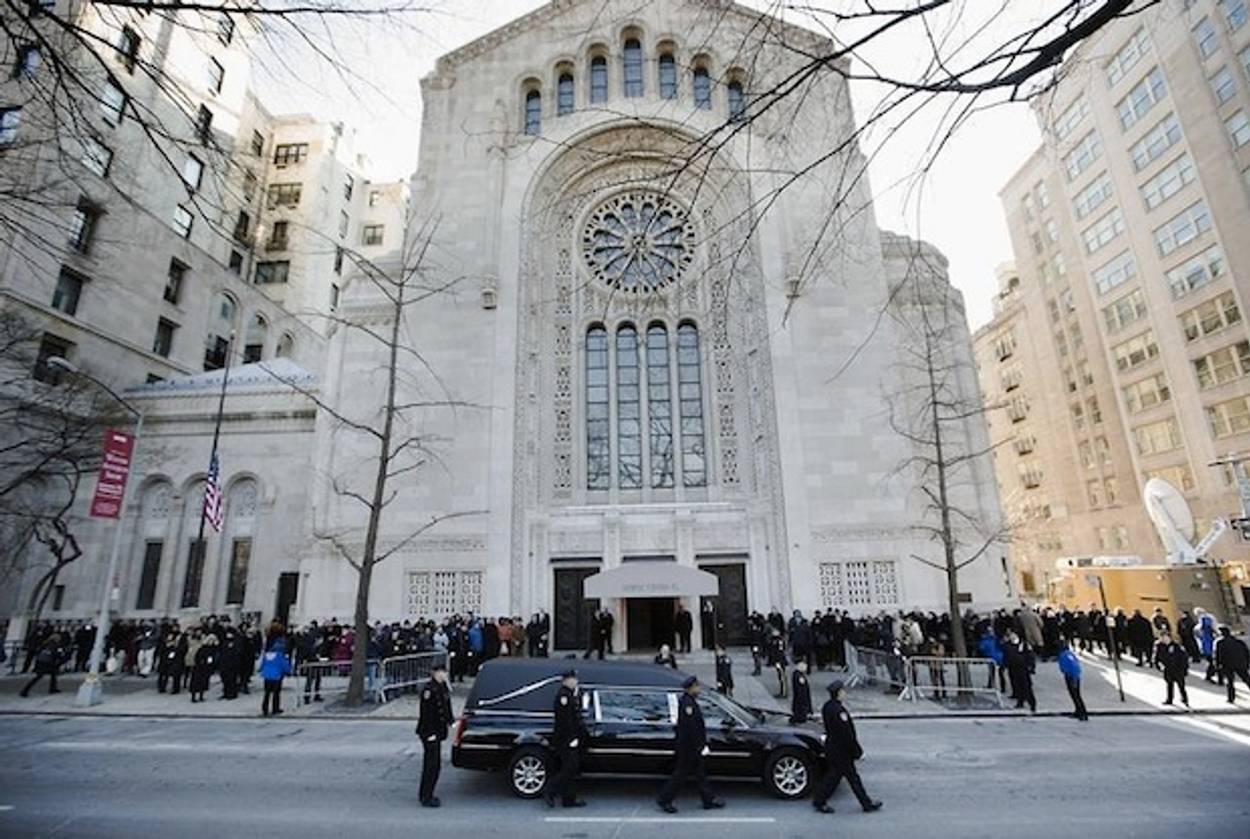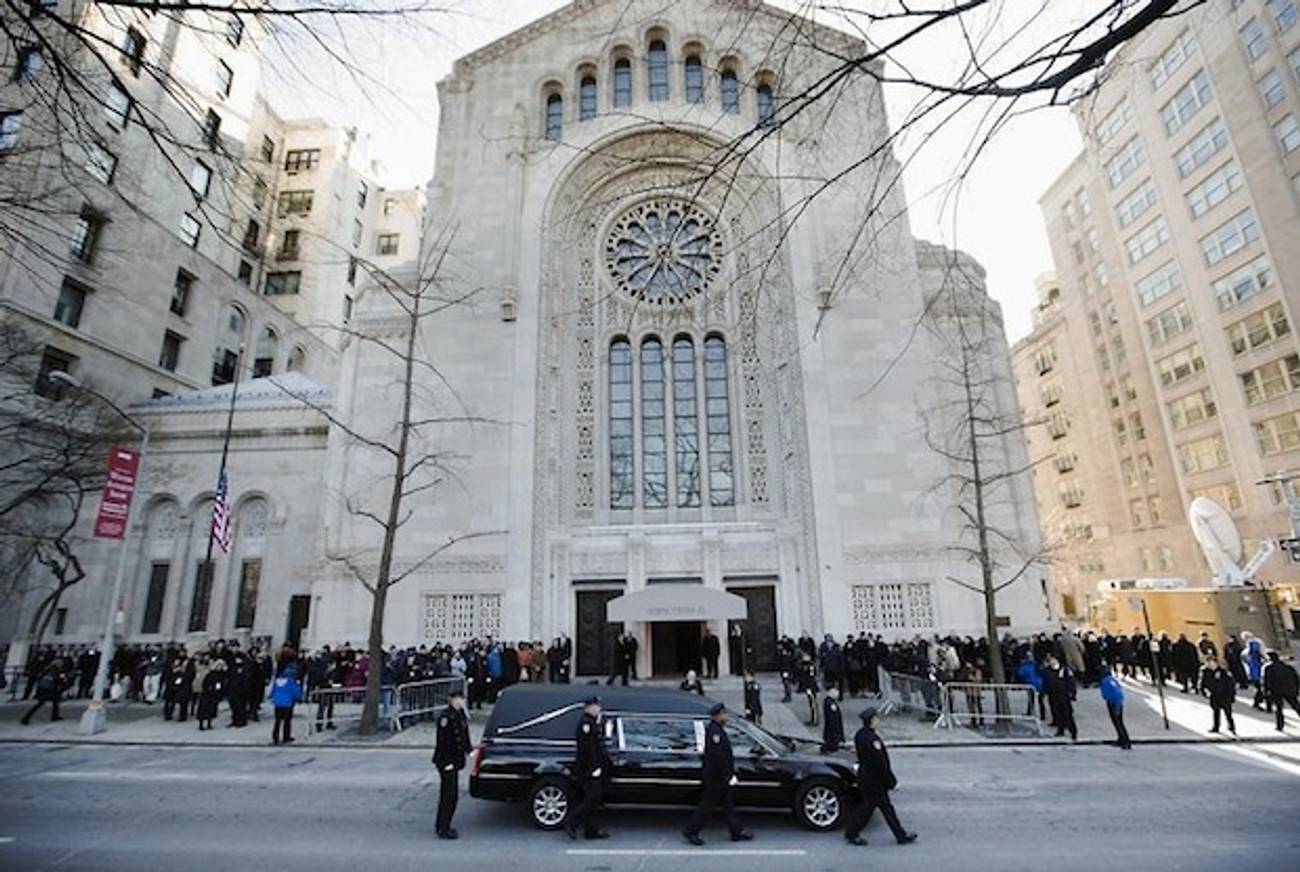A Final New York Moment With Ed Koch
A dispatch from Hizzoner’s funeral




Let’s start with one axiomatic truth: The only truly qualified person to eulogize Ed Koch is Ed Koch.
Despite this, thousands of New Yorkers packed the pews at Manhattan’s Temple Emanu-El yesterday and stood within its soaring Neo-Romanesque walls–the 5th Avenue analog of the Basilica di San Petronio–to hear others try. And, of course, to spend one final New York moment with the Hizzoner.
“We began talking about his death in the 80s and his plans for it,” former Koch chief of staff Diane Coffey told the crowd. “Who else plans every detail of a burial?”
The details included an honor guard, a flyover of NYPD helicopters, and a parade of New York mayors, senators, and governors–past, present, and future–hemmed into the temple by the city’s kith and kin, a mix of business suits, police caps, blue jeans, winter coats, white faces, black faces, and everything in between.
New Yorkers watched as the casket, draped in the tricolore city flag, was carried in, past the rolling cameras, on the shoulders of six of New York’s finest. Winter sunlight pierced through the ridges of the temple’s stained glass windows (you knew Koch had planned this too) and the coffin was set. The flag was removed, leaving an oak box, stubbornly plain except for the large Star of David–an emblem for the Hizzoner himself.
The prayers began, the family spoke, and the politicians read their lines with conviction, led by New York City Mayor Michael Bloomberg, a fellow three-termer, who, for a rare moment was able to make English sound like his first language.
“A Polish Jew in an Episcopal graveyard in a largely Dominican neighborhood. What could be more New York, or even more Ed Koch?”
Reading from an iPad, Bloomberg called Koch New York’s Moses “but with less hair” and added that Koch had “convinced us we could be great again.” Where liveliness and ebullience were required for Bloomberg to meet the moment, former President Bill Clinton–who flew home early from Japan–knew that he owed the day a small dose of gravitas and told of the many letters he received from Koch over the years.
“We miss you so much,” Clinton said in his lean-in voice. “Because we all know we are doing a lot better because you lived and served.”
Then there was Ido Aharoni, the Israeli consul general, would have made Koch blush as he relayed the most elusive of honorific an Israeli can bestow upon a man of the Diaspora, calling Koch “one of us.” He spoke about the lifelong friendship between Koch and Jerusalem Mayor Teddy Kollek, whom Koch referred to as “the mayor of all mayors”–quite a sobriquet considering the source.
Aharoni also explained that Koch had “literally bled for the Jewish state,” after being struck with a rock thrown by a Palestinian protestor during one of his many visits to Israel. (Koch had quipped to his Israeli counterparts that the rock had been aimed at them.)
But speeches from coworkers and staff members did the best at capturing Koch at his headstrong best. During a video for Mayor Bloomberg’s State of the City, Koch was famously filmed on the Queensboro Bridge–which had been renamed the Ed Koch Queensboro Bridge–shouting “Welcome to my bridge!” to the rush of oncoming traffic.
One coworker told of how Koch, for 20 minutes after the filming had concluded, simply kept waving and shouting at the passing cars. Koch also frequently made known his demand that there never be any tolls on the Ed Koch Queensboro Bridge. Apparently Koch believed that the bridge was actually his. He wanted to make sure everyone else thought so too.
***
Just when you thought nothing could top the tributes, there was still a New York ending to be had. The prayers all said, the six svelte policemen reconvened to carry out the casket and load it for the short journey to Koch’s resting place, the Trinity Church Cemetery, the last legal place a body can still be buried in Manhattan. As Coffey noted, it was chosen partially because of its easy subway accessibility. Even in the afterlife, Ed Koch expects your attention.
As the men lifted the coffin, Temple Emanu-El’s 10,000 pipe organ–one of the largest, if not the largest organ to ever be built–began softly playing out a tune immediately familiar to everyone there: Frank Sinatra’s “New York, New York.”
It was hammy perfection, the mourners chuckled and sighed. By the time the coffin was halfway down the grand aisle, the song was blasting and the crowd had broken out into loud applause. Out went Koch on the highest of notes.
Adam Chandler was previously a staff writer at Tablet. His work has appeared in the New York Times, the Wall Street Journal, the Atlantic, Slate, Esquire, New York, and elsewhere. He tweets @allmychandler.